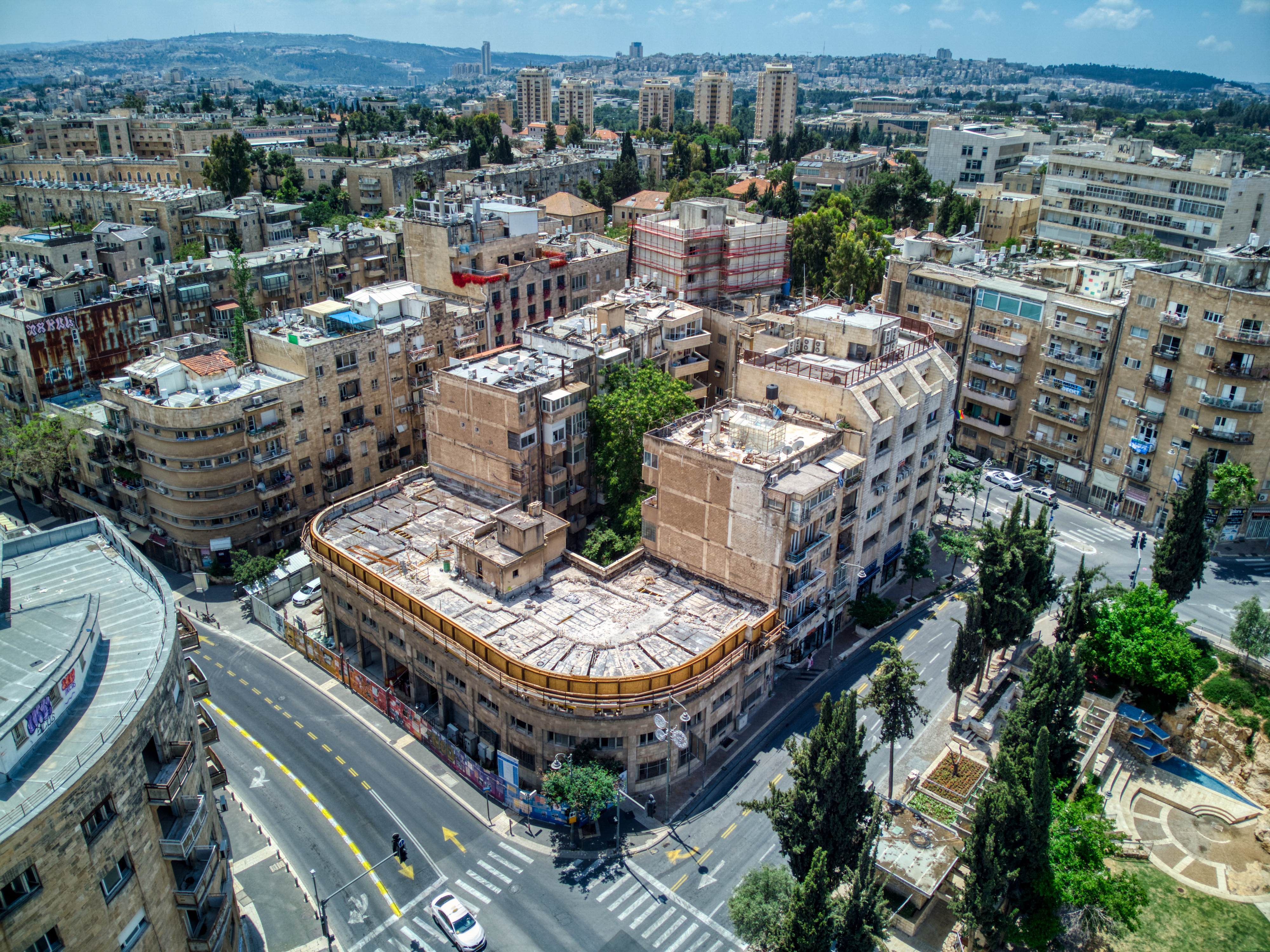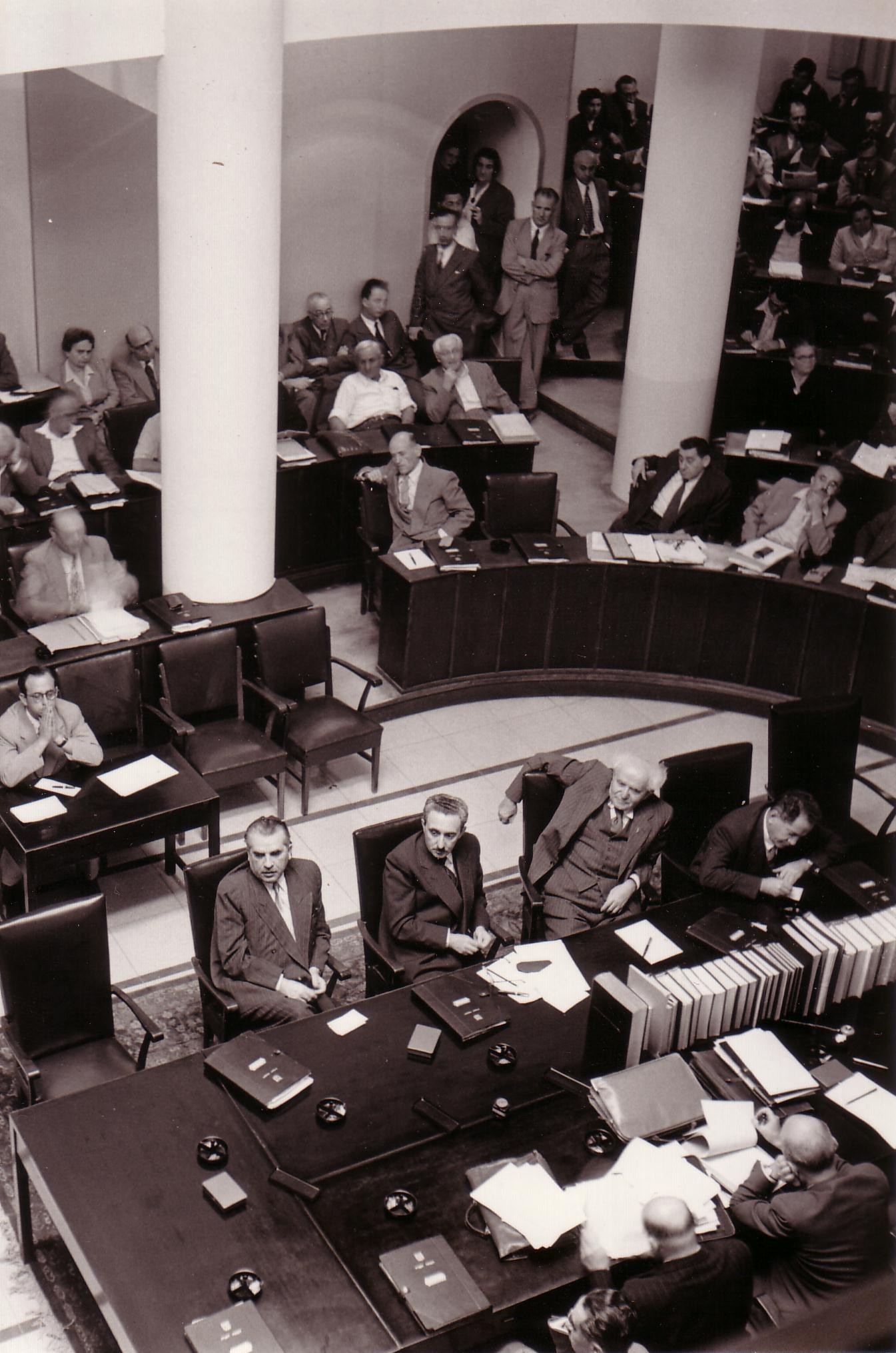Froumine House on:
[Wikipedia]
[Google]
[Amazon]


 Froumine House (or Frumin House) (; ''Beit Frumin''; also known as the ''Old Knesset'') was the temporary abode of the Israeli Parliament, the
Froumine House (or Frumin House) (; ''Beit Frumin''; also known as the ''Old Knesset'') was the temporary abode of the Israeli Parliament, the


Knesset
The Knesset ( , ) is the Unicameralism, unicameral legislature of Israel.
The Knesset passes all laws, elects the President of Israel, president and Prime Minister of Israel, prime minister, approves the Cabinet of Israel, cabinet, and supe ...
, from 1950 to 1966. The building is at 24 King George Street in downtown Jerusalem. The first to the fifth Knesset sessions were conducted there.
History
The three-story building is named after the Froumine family, who initiated its construction for residential and business purposes in 1947. The Froumine family manufactured baked goods and the building was a residence with shops on the ground floor, based on plans by architect Reuven Abram (1892-1978). It was originally intended to be a six-story structure however only three levels had been completed when construction was suspended during the1947–1949 Palestine war
The 1948 Palestine war was fought in the territory of what had been, at the start of the war, British-ruled Mandatory Palestine. During the war, the British withdrew from Palestine, Zionism, Zionist forces conquered territory and established ...
.
In his book on construction in Jerusalem during the British Mandate, architectural historian David Kroyanker
David Kroyanker (; born 1939) is an Israeli architect and architectural historian of Jerusalem. He has written dozens of popular books about Jerusalem neighborhoods, streets, and buildings, and urban planning.
Biography
Kroyanker was born and ...
wrote that at the end of 1948, the government chose the building (then only a skeleton) as the home of the Knesset because of its large ground-floor hall. The hall, which had an upper balcony, was originally meant to be a bank. In a Haaretz
''Haaretz'' (; originally ''Ḥadshot Haaretz'' – , , ) is an List of newspapers in Israel, Israeli newspaper. It was founded in 1918, making it the longest running newspaper currently in print in Israel. The paper is published in Hebrew lan ...
article in 2003, journalist Esther Zandberg speculated: "The first building's city-center site, and the location of the plenum hall at street level were, without a doubt, an urban expression of a point of view that saw democracy and the Knesset as part of everyday civil existence, in contrast with its isolation in the present-day fortified compound". Kroyanker categorizes the building, which stretches between Be'eri and Schatz Streets as having been planned in the "corridor" style (a continuum of construction along the length of the street), which is characteristic of the main streets in the city center and imparts a European character to them.
The building, designed in the modern style typical of the Mandate period, has a convex corner that follows the line of the intersection, and a saw-tooth stone strip that divides the first two stories from the third story. The stone strip that is typical of Abram's style appears in many other buildings he designed in the city center, including the Beit Mar Chaim building opposite Beit Froumine.
Between 1950-1966
Up until the end of 1949, meetings of theProvisional State Council
The Provisional State Council (, ''Moetzet HaMedina HaZmanit'') was the temporary legislature of Israel from shortly before independence until the election of the first Knesset in January 1949. It took the place of His Majesty's Privy Council, ...
and the first Knesset sessions had been held in several Tel Aviv
Tel Aviv-Yafo ( or , ; ), sometimes rendered as Tel Aviv-Jaffa, and usually referred to as just Tel Aviv, is the most populous city in the Gush Dan metropolitan area of Israel. Located on the Israeli Mediterranean coastline and with a popula ...
locations, including the Tel Aviv Museum of Art
The Tel Aviv Museum of Art ( ''Muzeon Tel Aviv Leomanut'') is an art museum in Tel Aviv, Israel. The museum is dedicated to the preservation and display of modern and contemporary art both from Israel and around the world.
History
The Tel Aviv ...
in Dizengoff House (today Independence Hall
Independence Hall is a historic civic building in Philadelphia, where both the United States Declaration of Independence, Declaration of Independence and the Constitution of the United States were debated and adopted by the Founding Fathers of ...
), and in the "Kessem" movie house located at Knesset Square.
On 26 December 1949, the Knesset moved to Jerusalem, where it held its first meetings in the Jewish Agency's impressive semi-circular building in Rehavia. After weighing several options, including the King David Hotel
The King David Hotel (; ) is a 5-star hotel in Jerusalem and a member of The Leading Hotels of the World. Opened in 1931, it was built with locally quarried pink limestone and was founded by Ezra Mosseri, a wealthy Egyptian Jewish banker. It ...
, the Knesset selected Froumine House for a more permanent meeting place. At the time, it was still-unfinished. From 13 March 1950, meetings of the Knesset were held there.
During Knesset sessions, King George Street in the area of Froumine House was closed for traffic, which caused great disruption to residents of the city. In addition, the location of Knesset meetings on a main street in the city-center resulted in security problems. During the demonstration against the Reparations Agreement between Israel and West Germany
The Reparations Agreement between Israel and the Federal Republic of Germany (, "Luxembourg Agreement", or ', "''Wiedergutmachung'' Agreement"; , "Reparations Agreement") was signed on September 10, 1952, and entered in force on March 27, 1953.Hon ...
in 1952, protesters threw stones at the building, shattering windows and penetrating the plenum chamber. A hand grenade was also thrown into the plenum hall in 1957, which wounded Golda Meir, David Ben-Gurion, Moshe Shapira and Moshe Carmel
Moshe Carmel (; 17 January 1911 – 14 August 2003) was an Israeli Major-General and politician who served as Minister of Transportation for eight years.
Biography
Born in Mińsk Mazowiecki in the Russian Empire (today in Poland), Carmel emig ...
. Nevertheless, the "old Knesset building" was the site of a number of formative civil events, such as the passage of the Law of Return (1950), the Citizenship Law (1952) and the abolition of the death penalty (1954) although the execution of Adolf Eichmann
Otto Adolf Eichmann ( ;"Eichmann"
''Random House Webster's Unabridged Dictionary''. ; 19 March 1906 – 1 Ju ...
was carried out in 1962 in Ramla.
In 1956, in a green garden near the building, on the "Bor Shiber" lot, the distinctive bronze ''Random House Webster's Unabridged Dictionary''. ; 19 March 1906 – 1 Ju ...
Knesset Menorah
The Knesset Menorah (Hebrew: מנורת הכנסת ''Menorat HaKnesset'') is a bronze menorah (Temple), menorah that is 4.30 meters high and 3.5 meters wide and weighs 4 tons. It is located at the edge of Wohl Rose Park (Hebrew ''Gan Havradim'', ...
, a gift from the United Kingdom, was placed. The garden was then renamed "Gan HaMenora
The word Gan or the initials GAN may refer to:
Places
* Gan, a component of Hebrew placenames literally meaning "garden"
China
* Gan River (Jiangxi)
* Gan River (Inner Mongolia),
* Gan County, in Jiangxi province
* Gansu, abbreviated ''G� ...
" ("Garden of the Menorah"). When the new Knesset building was inaugurated, the Menorah was moved to the Wohl Rose Park
Wohl Rose Park (Hebrew: גן הוורדים, ''Gan HaVradim'') is a public garden in Givat Ram, Jerusalem, located opposite the Knesset and government precinct, at the foot of the Israeli Supreme Court.
The park was established in 1981. Over 400 ...
. In 2012 a nearby parking lot still carried the name "Menorah Parking".
The Knesset relocation occurred during the Sixth Knesset
Elections for the sixth Knesset were held in Israel on 2 November 1965. Voter turnout was 85.9%.Dieter Nohlen, Florian Grotz & Christof Hartmann (2001) ''Elections in Asia: A data handbook, Volume I'', p124
Background
Prior to the elections, ...
. The last meeting of the Knesset at Froumine House was held on 11 August 1966. After recess, the session resumed on 30 August 1966, at its new campus in the Jerusalem neighborhood of Givat Ram
Givat Ram () is a neighborhood in central Jerusalem. It is the site of Kiryat HaMemshala (Hebrew language, Hebrew: קריית הממשלה, ''lit.'' Government complex), which includes many of Israel's most important national institutions, among t ...
.
Between 1967-2010
After the departure of the Knesset, Froumine House was used by various government agencies. The Ministry of Tourism was located in the building until 2004. The building was then used by various branches of theMinistry of Religious Services
The Ministry of Religious Services (), formerly the Ministry of Religious Affairs and Ministry of Religion, is a government ministry of Israel that handles Jewish and other religious affairs.
Responsibilities
The Ministry of Religious Services a ...
, including the Rabbinical courts of the Jerusalem District and the Great Rabbinical Court of Appeals. The last of these vacated in 2015 as the building began to be refurbished into a Museum of the Knesset.
In 2002, the State of Israel
Israel, officially the State of Israel, is a country in West Asia. It Borders of Israel, shares borders with Lebanon to the north, Syria to the north-east, Jordan to the east, Egypt to the south-west, and the Mediterranean Sea to the west. Isr ...
sold Froumine House to a private individual for 10 million shekels. The new owners filed an application with the District Planning and Building Committee to demolish Froumine House and construct a 16-story structure on the site. In response, the council for The Society for Preservation of Israel Heritage Sites
''The'' is a grammatical article in English, denoting nouns that are already or about to be mentioned, under discussion, implied or otherwise presumed familiar to listeners, readers, or speakers. It is the definite article in English. ''The' ...
(SPIHS) protested the demolition plan. A number of Knesset members sponsored a bill which was passed in 2010, stipulating that the building was to be preserved, its interior section was to be restored, and a "Museum of the Knesset" was to be established there. By law, the building was to be confiscated from its owners and handed back to the State of Israel; the owners were to receive NIS 45 million.
The 2009 Report of the State Comptroller of Israel
The State Comptroller of Israel ( ''Mevaker HaMedina'', , literally: ''Critic of State'') inspects, reviews, and audits the policies and operations of the government of the State of Israel. The State Comptroller's Office is also the government's ...
criticized the sale and re-purchase of Froumine House by the state.
References
{{coord, 31, 46, 49, N, 35, 12, 56, E, region:IL_type:landmark_source:kolossus-hewiki, display=title Buildings and structures in Jerusalem Knesset Former seats of national legislatures